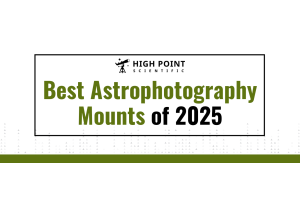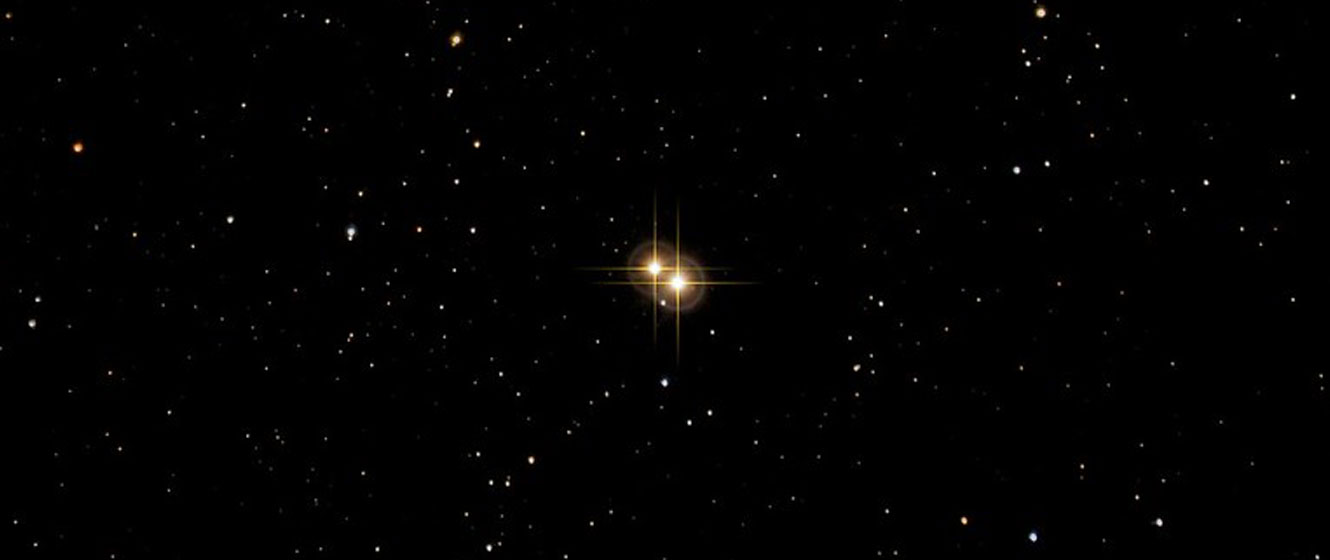
If there’s one common misconception that newcomers to astronomy often have, it’s that you must own a telescope to enjoy the night sky. A telescope is a wonderful tool that can allow you to explore the universe around us, but that’s not necessarily the only option.
In fact, many experienced observers will advise beginners to learn the night sky and to start their journey with binoculars instead. There are a multitude of objects within range of most binoculars (for example, 10x50 binoculars or larger), but before you dive into that ocean, let’s start by getting your feet wet with ten of the best.
Of course, almost any object visible with the naked eye is better seen with binoculars. With that in mind, the following can all be seen with the naked eye and can be considered go-to targets for binocular observers too:
- Messier 42, the Great Nebula in Orion
- Messier 45, the Pleiades star cluster in Taurus
- The Coma Star Cluster in Coma Berenices
- Mizar & Alcor, an easy double star in Ursa Major
- Messier 31, the Andromeda Galaxy in Andromeda
Beyond these sights, there are ten more that are (arguably) better observed with binoculars and that can be easily seen under suburban skies. Let’s start in the autumn, when the weather is getting colder but the nights are getting longer.
1. The Double Cluster
Our first, the famed Double Cluster, can be found midway between the constellations of Cassiopeia the Queen, and Perseus the Hero. The clusters can be seen with the naked eye under relatively clear, dark skies and both have been known since ancient times. Greek astronomers even gave them the designations of h and Chi Persei, believing them to be faint stars.
Binoculars, however, tell a different story and even a low power of 8x will reveal their stellar nature. Of the two, h Persei appears much smaller and more compact, with a very prominent blue-white pairing of stars in the center. Chi appears about twice as large and more sparsely scattered. The stars are mostly uniform in magnitude, with a few stand-out exceptions.
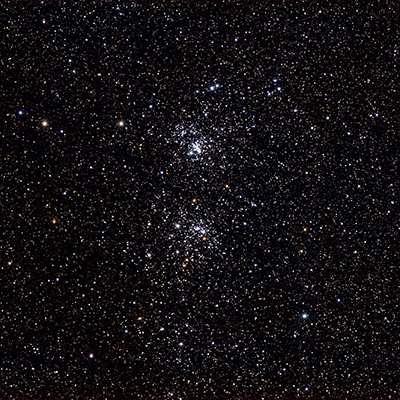
Image Credit: Genuson
2. Mirfak’s Cluster
Moving down through Perseus, we come to Mirfak, or Alpha Persei, the constellation’s brightest star. With the naked eye, you might notice a faint scattering of tiny stars surrounding it, but binoculars will truly allow the cluster to shine. Mirfak is, of course, the brightest with the majority of stars appearing just below it, as though Mirfak itself were trailing the stars behind it. This is a true star cluster, some 600 light-years away, and it covers an area of roughly six full Moons in the sky.
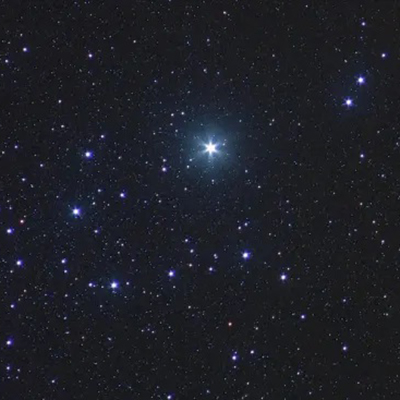
Image Credit: Martin Gembec (astrofotky.cz/~MaG)
3. The Hyades Cluster
Follow the curve of Perseus down toward the south and we come to Taurus, the Bull. This constellation’s most famous star cluster is, of course, Messier 45 (M45), the Pleiades or Seven Sisters. Few astronomers will pass up an opportunity to spend some time with that cluster, but the Hyades deserve some attention, too.
The Hyades cluster is easily visible to the naked eye and appears as a horizontal V-shape in the sky. The stars represent the head of the bull, with the bright red giant star Aldebaran marking the eye of the beast. It’s a large cluster, roughly five and a half degrees across, making it too wide to fit within the field of view of a telescope.
However, turn your binoculars toward the cluster and a multitude of fainter stars become apparent. In particular, look out for the multiple star Theta Tauri. This close pair of equally bright white stars appears midway between Aldebaran and the bottom of the V. There’s also a wider double, Sigma Tauri, that appears to the south of Aldebaran. (Aldebaran is not a member of the cluster itself; the star is roughly 65 light-years away while the remaining stars are more than double the distance.)
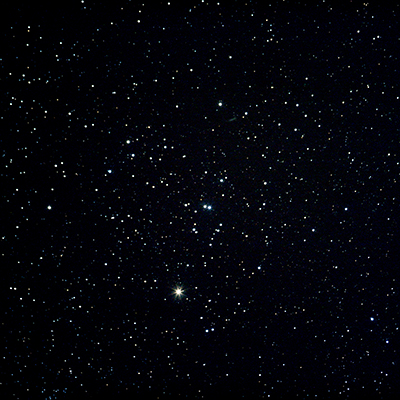
Image Credit: Todd Vance
Taurus is a constellation that’s easily seen from mid-autumn through late spring, giving you plenty of time to enjoy the sights it has to offer. During the winter months, you can find it by following the three stars of Orion’s belt north to Aldebaran and the Hyades.
4. Messier 41
Follow those same three stars in Orion’s belt south and we come to Sirius, the brightest star in the constellation of Canis Major, the Great Dog, and the brightest star in the entire night sky. Due south of that star, and within the same binocular field of view, is our next target, Messier 41 (M41).
Faintly visible to the naked eye, this open star cluster is a gem, one of the finest in the sky. While it’s best observed with a telescope, it shows a surprising amount of detail in binoculars.
Compared to most other deep sky objects, M41 appears quite large in binoculars and has a definite shape to it. It looks as though there's a circular hole on the western edge of the cluster that gives it the appearance of a lobster with its claws outstretched.
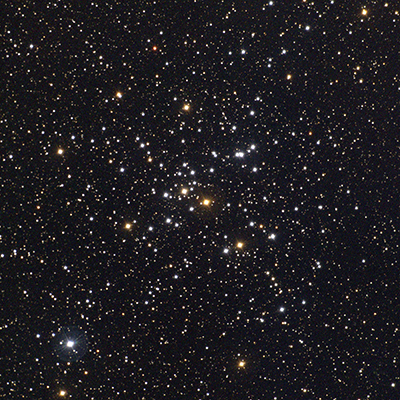
Image Credit: NOIRLab / NSF / AURA
5. Messier 44
Returning to the constellations of the zodiac, following Taurus is Gemini, the Twins, and then there comes Cancer, the Crab. One of the fainter constellations, you may have a hard time locating it if you live under light-polluted suburban skies.
Draw a line between Castor and Pollux, the two brightest stars of Gemini, and Regulus, the brightest star in the next zodiac constellation, Leo the Lion. About midway along that line is Messier 44 (M44), the Praesepe or Beehive cluster. Under dark skies, you shouldn’t have any problem spotting this cluster with just your eyes.
Like the Hyades and Pleiades, this is a relatively large cluster, making it better suited to observation with binoculars. While it can still fit within the telescopic field of view with a low magnification eyepiece, you’ll lose many of the surrounding stars, making the scene slightly less impressive.
Through even low powered binoculars, the stars appear scattered in an elongated diamond shape with a close double on the diamond’s northern tip. The brighter members of the cluster seem to form a pattern reminiscent of the constellation Cepheus, or a crooked house.
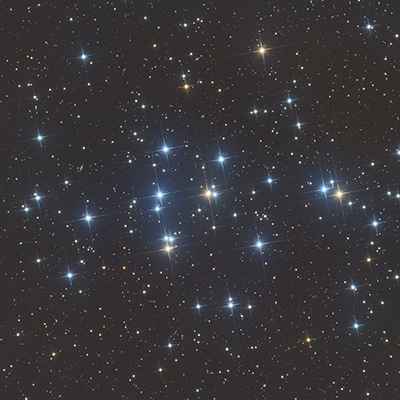
Image Credit: Fried Lauterbach
6. Nu Draconis
Cancer remains visible until late spring, by which time the stars of summer are rising toward the east. Look a little further toward the north and you’ll see the constellation of Draco, the Dragon, snaking around Polaris, the Pole Star.
Hidden within its head is Nu Draconis, also known as Kuma. The star is also sometimes known as “the eyes of the dragon” and it’s an appropriate name, for Kuma is an easy binocular double.
A low power of only 8x may split it, but otherwise regular 10x50 binoculars are more than enough to provide a fine view. You’ll see a close pair of twin white suns of equal brightness, making this a double that should be on every binocular observer’s favorite list.
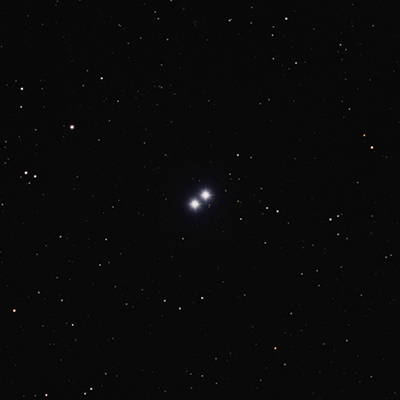
Image Credit: David Ritter
7. Messier 13
Not too far away, in neighboring Hercules, is the northern hemisphere’s finest globular cluster. Unlike the clusters we’ve seen so far, a globular cluster is spherical, and while they can appear quite stunning in telescopes, they’re often too small to be fully appreciated in binoculars.
That being said, within Hercules we find Messier 13 (M13), the Hercules Cluster. It’s just beyond the reach of many naked eye observers, but if you have good eyesight and clear skies you might just be able to glimpse it.
There are an estimated two or three hundred thousand stars in this cluster, and while you won’t be able to see the individual members with binoculars, it’s one of the few globulars you can easily see under light polluted suburban skies.
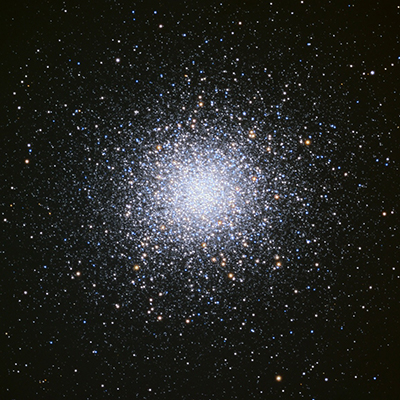
Image Credit: Sid Leach/Adam Block/Mount Lemmon SkyCenter
Through low powered binoculars the cluster appears as a very small, faint and fuzzy star close to two other stars. It’s almost comet-like, with a central, star-like core. While you’re discovering this cluster for yourself, consider the following facts:
- You’re looking at an object that’s roughly 22,000 light-years away.
- It’s nearly 150 light-years in diameter - that’s further than the Hyades!
- It’s one of the oldest globular clusters, with an estimated age of nearly 12 billion years. In comparison, the Earth is estimated to be just 4.5 billion years old.
8. Messier 6 & Messier 7
Turning to the southern horizon, we find Scorpius the Scorpion. Observers in the mid northern or southern latitudes are able to see the tail of the scorpion, and it’s here that we find two star clusters within the same field of view.
Messier 6 (M6), the Butterfly Cluster, is visible with binoculars but is best seen with a telescope. Meanwhile its companion, Messier 7 (M7), Ptolemy’s Cluster, is an easy target that can be appreciated in binoculars of all sizes.
M7 appears large and pretty in even low powered binoculars. There’s a close core of possibly hundreds of stars, with a line of three stars to the west that mimics the head of Scorpius itself.
Even under light polluted skies, a regular set of 10x50 binoculars will show the cluster as large and nicely scattered - not too dense or sparse. More powerful binoculars reveal a malformed X at its center, with the north-eastern arm broken.
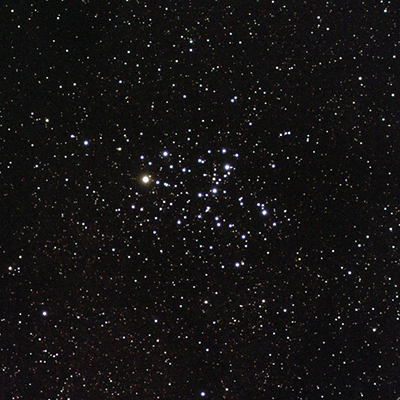
Image Credit: Ole Nielsen
9. The Lagoon Nebula
Winter has an outstanding, naked eye nebula in the form of Messier 42 (M42), the Great Orion Nebula. It only seems fair that summer should have the same. Messier 8 (M8), the Lagoon Nebula in Sagittarius, may be best seen from the southern hemisphere, but is still visible to the naked eye and worth seeking out with binoculars.
Even with low powered binoculars under light polluted skies, the nebula can be very faintly seen as a dark, misty elongated patch running east/west. It’s clearly divided into two equal parts by a break running north/south down the middle, with the eastern hemisphere appearing a little brighter than the west.
The Lagoon comes with a bonus; there’s a small open star cluster embedded within it. Like the nebula itself, the stars of NGC 6530 appear divided into two separate groups, with each half of the nebula containing a smattering of stars.
Under good conditions and darker skies, you may also be able to catch the smaller and fainter Messier 20 (M20), the Trifid Nebula, within the same field of view.
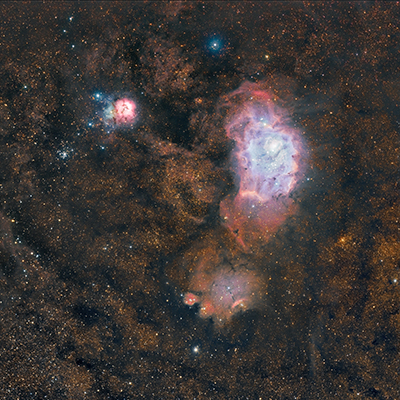
Image Credit: Allanalaoui
10. 61 and Omicron Cygni
Lastly, we come to Cygnus, the Swan, a large constellation that soars high in the late summer skies. Its brightest star, Deneb, marks the tail of the swan while Delta Cygni marks its western wing tip. Roughly midway between the two is 61 Cygni, a naked eye star that nicely splits into a pair of golden suns with 10x50 binoculars.
Slightly closer to Deneb is Omicron Cygni, a reasonably bright orange star. Both 61 and Omicron can fit within the same field of view as Delta, while shifting your gaze toward the north-west then allows Deneb to slip into view as Delta vanishes.
Most of these sights can also be enjoyed through a telescope, but if you’re short on time or simply don’t have your scope with you, binoculars provide a fantastic grab ‘n go solution. Whether you’ve invested in a telescope already or are just starting out, binoculars will bring the universe to your backyard!
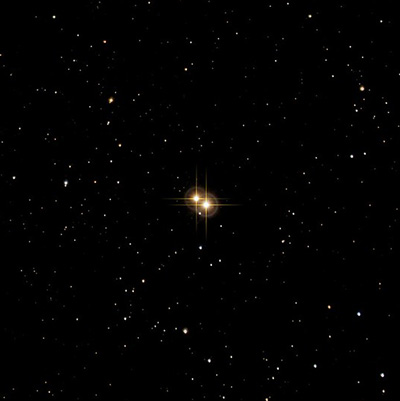
Image Credit: Tom and Jane Wildoner/ Dark Side Observatory

Learn More
Interested in learning more about what you can observe in the night sky? Check out our Astronomy Hub to learn more!







